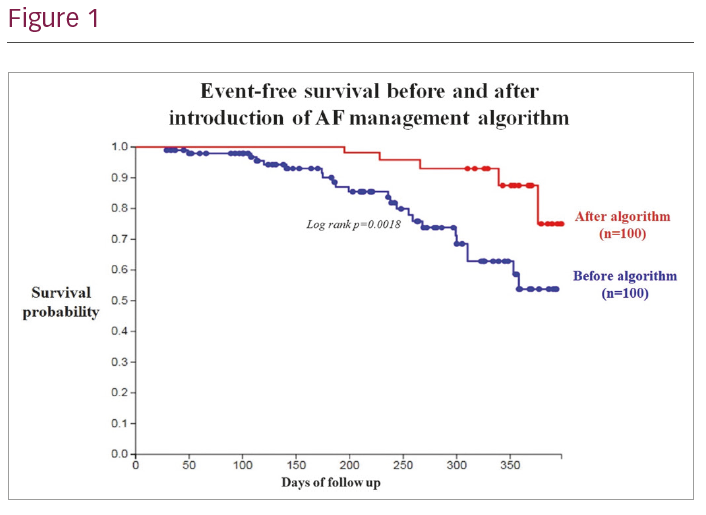Introduction: New-onset or decompensated atrial fibrillation (AF) is a common presenting complaint in the Emergency Department, and causes considerable morbidity. The acute management of AF presents challenging decisions regarding anticoagulation, rate and rhythm control, and whilst ESC and NICE guidelines are well-established, compliance with these recommendations is not always assured, particularly for the busy generalist.
Methods: The presenting complaint was examined for 2,105 consecutive medical admissions to London’s North Middlesex University Hospital (NMUH), identifying 100 patients (4.7%) with acute AF. For each patient, 36 indices and performance indicators were collected and analysed against international standards set by NICE and the ESC. Deficiencies were identified in documentation, risk stratification, anticoagulation and arrhythmia management decisions. With cross-specialty collaboration, a single-page AF management algorithm was established using sequential “Plan-Do-Study-Act” methodology and with reference to international guidelines. This algorithm was adopted as the hospital’s gold standard, and a further 100 consecutive patients with acute AF were analysed prospectively. The same performance indicators – plus a composite end-point of adverse outcomes (AF-associated readmission, stroke, cardiac death or major bleeding) – were examined and the impact of the algorithm assessed.
Results: Patients’ baseline characteristics were similar before and after the introduction of the algorithm. Algorithm implementation significantly reduced the proportion of patients exposed to unnecessary stroke risk (30% versus 4%, p<0.0001); improved identification and documentation of thromboembolic potential (50% versus 88%, p<0.0001), reduced incorrect drug decisions (12% versus 2%, p=0.01), reduced contraindicated rhythm control (8% versus 0%, p=0.007), and increased direct oral anticoagulant (DOAC) prescribing (38% versus 86%, p<0.0001) over warfarin. After a mean follow-up of 248 ± 91 days, patients exposed to the algorithm had a significant reduction in AF-associated hospital readmission (18% versus 6%, p=0.015) and in a composite of adverse outcomes (22% versus 6%, p=0.0018). Multivariate analysis adjusting for age, gender and history of left ventricular systolic dysfunction (LVEF <50%) demonstrated that failure to adhere to the algorithm was associated with adverse outcomes (HR 4.92 [1.9–12.8], p=0.001).
Conclusion: Using established quality improvement methodology and cost-neutral multi-disciplinary expertise, implementation of ESC and NICE guideline-directed management at the point of admission has significantly improved the quality of care for patients with acute AF at NMUH.








